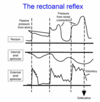2.5.2 Gastrointestinal Motility and Dysmotility IV Flashcards
Describe the coordinated muscle contraction and relaxation during peristalsis of the small intestine
circular mm narrows lumen and displaces contents, longitudinal mm relaxes at site of circular contraction and contracts to shorten and widen lumen downstream

Describe the process of vomiting and how it might be triggered.
Retroperistalsis triggered by pharyngeal stimulation, pain, drugs, vertigo, hormones
Retroperistalsis from intestine to stomach → relaxation of pylorus → large duodenal and gastric contractions

What is the power propulsion in descending and sigmoid colon?
stimulated by incoming chyme into cecum → loss of haustra, large contraction

Describe the contractile pattern of the large intestine
shallow peristaltic waves to allow back flow and slow propulsion, segmenting contractions

What are the characteristics of Hirschprung’s Disease?
congenital, neural crest cells stop growing, failure of normal peristalsis and sphincter control
What is fecal impaction?
prolonged constipation, can lead to ulcer, bleeding, or perforation
What is Dyssynergic defecation?
pelvic floor dysfunction, rectal hyposensitivity and failure to relax sphincters
What is bloating?
abdominal distension due to diminished propulsion and high sensitivity or gas

What is the muscular actions for defecation?
relaxation of external sphincter and puborectalis mm, contraction of abdominal mm/diaphragm

What is the role of the different sphincters in rectal mobility?
internal is normally contracted and relaxes with stool pressure, external is
normally relaxed and contracts when internal is relaxed until defecation
Describe the rectoanal reflux
Motility of the rectum and anal sphincters in response to rectal filling and during defecation. Note that filling of the rectum with stool causes an initial decrease in internal anal sphincter tone, which is counterbalanced by a reflex contraction of the external anal sphincter. The internal sphincter then accommodates to the new rectal volume, allowing relaxation of the external anal sphincter. Finally, defecation occurs when the external anal sphincter is relaxed voluntarily.

Describe the intrinsic peristaltic reflex of the small intestine.
The peristaltic reflex of the small intestine. Enteric sensory nerves detect chemical or mechanical stimulation of the mucosa or stretch of the muscle layer. Signals are transmitted in an oral or anal direction by interneurons. Excitatory motor nerves release acetylcholine (ACh) and substance P (SP) (and neurokinin A), which cause muscle contraction on the oral side of the stimulus. Inhibitory motor nerves release vasoactive intestinal peptide (VIP) and nitric oxide (NO), which cause muscle relaxation on the anal side of the stimulus.

What is diarrhea?
excessive number of propagating contractions and reduced time for reabsorption of water
What is constipation?
less than 3 BMs a week, absorption of too much water, common following surgery, low fiber, sedentary
How does the interdigestive phase of motility during sleep differ?
phase 1 is longer and phase 2 is less active

What can cause a mechanical obstruction?
scar, tumor, adhesions/surgery, impaction of feces, twisting of intestine
What is a pseudo obstruction?
poor propulsion w/o structural obstruction → due to meds, infection, nerve damage, Scleroderma
What is the importance of the Puborectalis muscle?
pulls on rectum, acute rectoanal angle to maintain continence, relaxes with decision to defecate

What are the major functions of the small intestine?
Digest macromolecular nutrients
Absorb digestive products
Absorption of fluid and electrolytes
Retain nutrients in small bowel until maximum digestion has occured
Move chyme from duodenum to point of emptying
What are the characteristics of IBS?
sensitivity of colon, gut flora and immune system may be causes, relieved with defecation, change in frequency and quality of stool
Describe the process of regulation of chyme into the cecum
chyme in ileum → receptors send signals to ileocecal sphincter to relax, chyme in cecum → signals override and signals sphincter to close and inhibit peristalsis

Describe the three types of contractile patterns in the small intestine
Different parts of the intestine are doing different types

Extrinsic innervation for the small intestine is provided by?
The vagus nerve and the sympathetic fibers from celiac and superior mesenteric ganglia
Describe the mixing pattern of motility
segmentation contraction with alternation of circular and longitudinal contraction mixes contents, mixture of propagating, random, and clustered contractions along tube

What is VIP?
Vasoactive intestinal peptide
What is the importance of retroperistalsis?
protective response to clear irritants or obstructions

What is the relative transit time of the different areas of the large time?
Cecum/ascending colon – short time, reservoir to transverse colon
Transverse colon – long time, primary absorption
Descending colon – long time, distensible for feces collection

What is the importance of the three phases of interdigestive motility
migrating motor complex (3 phases) clears intestines of residual material in between meals (motilin)
What is Fecal incontinence?
involuntary BM due to loss of sensation, scarring, following surgery
What are haustra and what are their role in segmented motility
shallow peristaltic waves to allow back flow and slow propulsion, segmenting contractions



